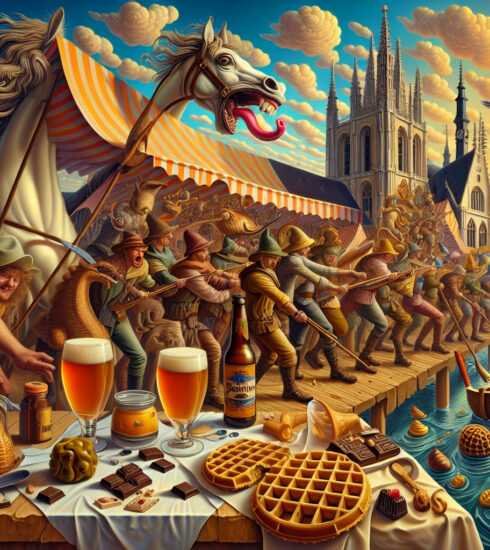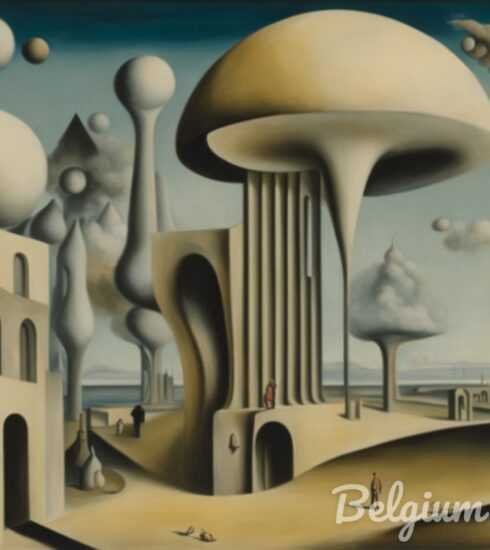The Enigmatic Allure of Belgian Abstraction: Unveiling the Distinctive Language of Visual Expression – A Captivating Artistic Journey
Introduction
Belgium, a country known for its rich artistic heritage, has made significant contributions to the world of abstraction. Belgian abstraction is characterized by its enigmatic allure and distinctive visual language. This art form, rooted in the early 20th century, has captivated art enthusiasts worldwide with its unique blend of color, form, and emotion.
In this article, we will delve into the fascinating world of Belgian abstraction, exploring its origins, key artists, defining characteristics, and its impact on the art world. Through a careful examination of historical context and artistic developments, we aim to unveil the secrets behind the enduring appeal of Belgian abstraction.
A Brief History of Belgian Abstraction
Belgian abstraction emerged in the early 20th century, at a time when artists were experimenting with new forms of visual expression. This period witnessed a shift from traditional representational art towards abstract forms, challenging the conventions of art at the time.
The influence of Belgian abstraction can be traced back to the late 19th and early 20th centuries. A key precursor to the movement was the Belgian Symbolist movement, which sought to depict the inner world of emotions and dreams. Artists such as Fernand Khnopff and James Ensor paved the way for abstraction by pushing the boundaries of representation and exploring the use of symbolism in their art.
The early 20th century marked a time of experimentation and artistic exploration in Belgium. Belgian artists were drawn to the avant-garde movements that were sweeping across Europe, such as Cubism and Futurism. These movements challenged traditional notions of representation and sought to capture the essence of modern life through abstract forms and fragmented perspectives.
One of the key figures in the development of Belgian abstraction was Piet Mondrian, a Dutch artist who spent a significant part of his career in Belgium. Mondrian’s iconic geometric compositions and use of primary colors laid the foundation for the De Stijl movement, which had a profound influence on Belgian abstraction.

Another pivotal moment in the history of Belgian abstraction was the formation of the art group “Cercle et Carré” in 1929. Led by Victor Servranckx and Joaquín Torres-García, this group aimed to promote abstract art and foster collaboration among artists. Their exhibitions and manifestos played a crucial role in shaping the direction of Belgian abstraction.
Belgian abstraction continued to evolve throughout the 20th century, with artists exploring new techniques and pushing the boundaries of abstraction. From the lyrical abstractions of Pol Bury to the geometric compositions of Pierre Alechinsky, Belgian artists have made significant contributions to the development and diversification of abstract art.
The Language of Belgian Abstraction
The distinctive language of Belgian abstraction is characterized by its emphasis on color, form, and emotion. Belgian artists sought to create visual experiences that went beyond representation, invoking a range of emotions and sensations through their art.
Color played a vital role in Belgian abstraction. Artists embraced vibrant palettes, using color as a means of expression and exploration. From the bold primary colors of Mondrian to the rich, atmospheric hues of Emile Claus, color became a vehicle for evoking emotion and capturing the essence of the artist’s vision.
Form was another crucial element in the language of Belgian abstraction. Artists experimented with new ways of representing form, moving away from the constraints of traditional representation. From the geometric shapes of Pol Bury to the gestural brushwork of Karel Appel, artists employed a diverse range of forms to express their abstract ideas.
Emotion was at the heart of Belgian abstraction. Artists sought to elicit emotional responses from their viewers, creating works that resonated on a deeply personal level. Through their use of color, form, and composition, artists aimed to convey the essence of their emotional experiences, inviting viewers to interpret and connect with the art in their own unique way.
Key Artists of Belgian Abstraction
Belgium has been home to a wealth of talented abstract artists who have made significant contributions to the development of Belgian abstraction. Here are some key artists who have left an indelible mark on the art world:
- Pierre Alechinsky: Known for his distinctive blend of calligraphy and abstract expressionism, Alechinsky’s works capture the spontaneity and energy of the creative process.
- Paul Delvaux: Delvaux’s dreamlike paintings combine elements of surrealism and abstraction. His haunting, otherworldly landscapes have become iconic symbols of Belgian art.
- Piet Mondrian: Although Mondrian was Dutch, his time in Belgium had a profound influence on his artistic development. His iconic grid compositions and use of primary colors laid the groundwork for the development of Belgian abstraction.
- Pol Bury: Bury’s lyrical abstractions explore movement and time, evoking a sense of rhythm and dynamism. His kinetic sculptures have earned him international acclaim.
These artists, among many others, have played a pivotal role in shaping the language and aesthetic of Belgian abstraction. Their unique styles and artistic visions continue to inspire and influence artists today.
The Legacy of Belgian Abstraction
The legacy of Belgian abstraction extends beyond the borders of Belgium, with its influence felt on a global scale. Belgian artists have made significant contributions to the development of abstract art, pushing the boundaries of visual expression and inspiring new generations of artists.
Belgian abstraction has shaped the art world in numerous ways:
- It has expanded the possibilities of artistic expression, challenging the conventions of representation and introducing new ways of seeing and experiencing art.
- It has fostered collaboration and exchange among artists, creating a vibrant artistic community. The formation of groups such as “Cercle et Carré” has contributed to the development and dissemination of abstract art.
- It has influenced other artistic movements and genres. Belgian abstraction has had a significant impact on movements such as Op Art and Kinetic Art, with its exploration of movement, color, and perception.
- It has enriched the cultural landscape of Belgium. Belgian abstraction has become an integral part of the country’s artistic identity, with numerous museums and galleries dedicated to showcasing the work of Belgian abstract artists.

The legacy of Belgian abstraction continues to be celebrated and recognized today. Artists and art enthusiasts from around the world are drawn to the distinctive language of Belgian abstraction, captivated by its enigmatic allure and rich artistic heritage.
Conclusion
Belgian abstraction stands as a testament to the power of visual expression. Rooted in a rich artistic heritage, this captivating art form continues to inspire and challenge artists today. Its distinctive language, characterized by its emphasis on color, form, and emotion, invites viewers to delve into a world of abstraction and connect with art on a deeply personal level.
Belgium, with its vibrant artistic community and rich cultural landscape, remains a hub for artistic innovation and exploration. The legacy of Belgian abstraction is evident in the works of contemporary artists, who continue to push the boundaries of visual expression and build upon the foundations laid by their predecessors.
Whether you are a seasoned art enthusiast or simply curious about the world of Belgian abstraction, exploring the unique language of this captivating art form is sure to be a rewarding experience.
For further reading and exploration of Belgian art and culture, we invite you to check out the following articles on our website:
- Discover the Richly Diverse World of Belgian Art
- Opulent Surrealism: Exploring the Surrealist Movement in Belgium
Delve into the fascinating world of Belgian abstraction and uncover the secrets behind its enduring allure.





